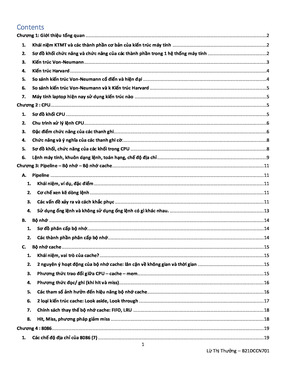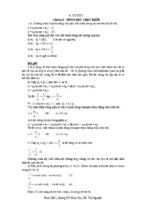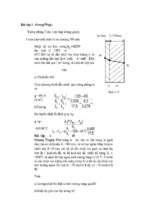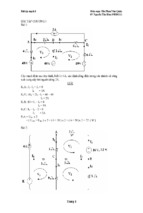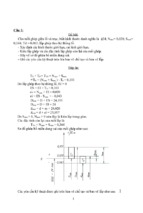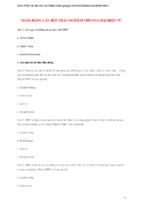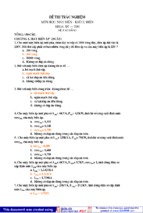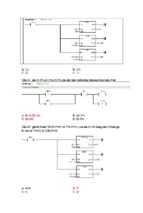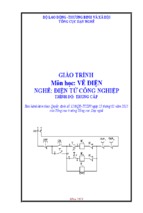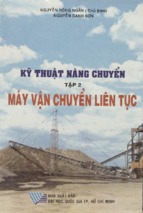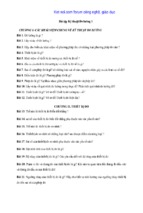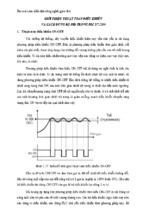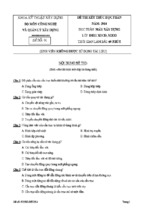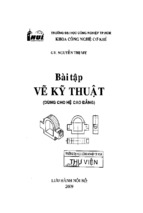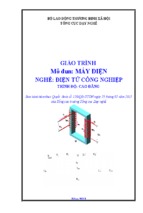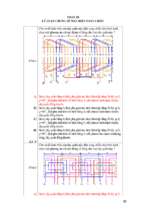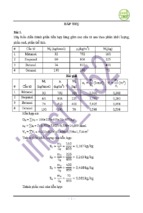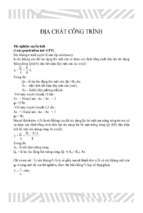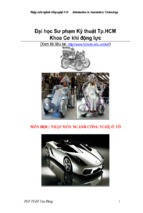Tài liệu tổng quan về lịch sử, cấu tạo, thuật toán điều khiển của hệ thống máy đo 3D
Coordinate Measuring
Machines and Systems
Second Edition
Edited by
Robert J. Hocken
& Paulo H. Pereira
Coordinate Measuring
Machines and Systems
Second Edition
MANUFACTURING ENGINEERING AND MATERIALS PROCESSING
A Series of Reference Books and Textbooks
SERIES EDITOR
Geoffrey Boothroyd
Boothroyd Dewhurst, Inc.
Wakefield, Rhode Island
1.
2.
3.
4.
5.
6.
7.
8.
9.
10.
11.
12.
13.
14.
15.
16.
17.
18.
19.
20.
21.
22.
Computers in Manufacturing, U. Rembold, M. Seth,
and J. S. Weinstein
Cold Rolling of Steel, William L. Roberts
Strengthening of Ceramics: Treatments, Tests, and Design Applications,
Harry P. Kirchner
Metal Forming: The Application of Limit Analysis, Betzalel Avitzur
Improving Productivity by Classification, Coding, and Data Base
Standardization: The Key to Maximizing CAD/CAM and Group
Technology, William F. Hyde
Automatic Assembly, Geoffrey Boothroyd, Corrado Poli,
and Laurence E. Murch
Manufacturing Engineering Processes, Leo Alting
Modern Ceramic Engineering: Properties, Processing, and Use
in Design, David W. Richerson
Interface Technology for Computer-Controlled Manufacturing Processes,
Ulrich Rembold, Karl Armbruster, and Wolfgang Ülzmann
Hot Rolling of Steel, William L. Roberts
Adhesives in Manufacturing, edited by Gerald L. Schneberger
Understanding the Manufacturing Process: Key to Successful CAD/CAM
Implementation, Joseph Harrington, Jr.
Industrial Materials Science and Engineering, edited by
Lawrence E. Murr
Lubricants and Lubrication in Metalworking Operations,
Elliot S. Nachtman and Serope Kalpakjian
Manufacturing Engineering: An Introduction to the Basic Functions,
John P. Tanner
Computer-Integrated Manufacturing Technology and Systems,
Ulrich Rembold, Christian Blume, and Ruediger Dillman
Connections in Electronic Assemblies, Anthony J. Bilotta
Automation for Press Feed Operations: Applications and Economics,
Edward Walker
Nontraditional Manufacturing Processes, Gary F. Benedict
Programmable Controllers for Factory Automation, David G. Johnson
Printed Circuit Assembly Manufacturing, Fred W. Kear
Manufacturing High Technology Handbook, edited by Donatas Tijunelis
and Keith E. McKee
23. Factory Information Systems: Design and Implementation for CIM
Management and Control, John Gaylord
24. Flat Processing of Steel, William L. Roberts
25. Soldering for Electronic Assemblies, Leo P. Lambert
26. Flexible Manufacturing Systems in Practice: Applications, Design,
and Simulation, Joseph Talavage and Roger G. Hannam
27. Flexible Manufacturing Systems: Benefits for the Low Inventory
Factory, John E. Lenz
28. Fundamentals of Machining and Machine Tools: Second Edition,
Geoffrey Boothroyd and Winston A. Knight
29. Computer-Automated Process Planning for World-Class Manufacturing,
James Nolen
30. Steel-Rolling Technology: Theory and Practice, Vladimir B. Ginzburg
31. Computer Integrated Electronics Manufacturing and Testing,
Jack Arabian
32. In-Process Measurement and Control, Stephan D. Murphy
33. Assembly Line Design: Methodology and Applications, We-Min Chow
34. Robot Technology and Applications, edited by Ulrich Rembold
35. Mechanical Deburring and Surface Finishing Technology,
Alfred F. Scheider
36. Manufacturing Engineering: An Introduction to the Basic Functions,
Second Edition, Revised and Expanded, John P. Tanner
37. Assembly Automation and Product Design, Geoffrey Boothroyd
38. Hybrid Assemblies and Multichip Modules, Fred W. Kear
39. High-Quality Steel Rolling: Theory and Practice, Vladimir B. Ginzburg
40. Manufacturing Engineering Processes: Second Edition,
Revised and Expanded, Leo Alting
41. Metalworking Fluids, edited by Jerry P. Byers
42. Coordinate Measuring Machines and Systems, edited by John A. Bosch
43. Arc Welding Automation, Howard B. Cary
44. Facilities Planning and Materials Handling: Methods and Requirements,
Vijay S. Sheth
45. Continuous Flow Manufacturing: Quality in Design and Processes,
Pierre C. Guerindon
46. Laser Materials Processing, edited by Leonard Migliore
47. Re-Engineering the Manufacturing System: Applying the Theory
of Constraints, Robert E. Stein
48. Handbook of Manufacturing Engineering, edited by Jack M. Walker
49. Metal Cutting Theory and Practice, David A. Stephenson
and John S. Agapiou
50. Manufacturing Process Design and Optimization, Robert F. Rhyder
51. Statistical Process Control in Manufacturing Practice, Fred W. Kear
52. Measurement of Geometric Tolerances in Manufacturing,
James D. Meadows
53. Machining of Ceramics and Composites, edited by Said Jahanmir,
M. Ramulu, and Philip Koshy
54. Introduction to Manufacturing Processes and Materials, Robert C. Creese
55. Computer-Aided Fixture Design, Yiming (Kevin) Rong and
Yaoxiang (Stephens) Zhu
56. Understanding and Applying Machine Vision: Second Edition,
Revised and Expanded, Nello Zuech
57. Flat Rolling Fundamentals, Vladimir B. Ginzburg and Robert Ballas
58. Product Design for Manufacture and Assembly:
Second Edition, Revised and Expanded, Geoffrey Boothroyd,
Peter Dewhurst, and Winston A. Knight
59. Process Modeling in Composites Manufacturing, edited by
Suresh G. Advani and E. Murat Sozer
60. Integrated Product Design and Manufacturing Using Geometric
Dimensioning and Tolerancing, Robert Campbell
61. Handbook of Induction Heating, edited by Valery I. Rudnev,
Don Loveless, Raymond Cook, and Micah Black
62. Re-Engineering the Manufacturing System: Applying the Theory
of Constraints, Second Edition, Robert Stein
63. Manufacturing: Design, Production, Automation, and Integration,
Beno Benhabib
64. Rod and Bar Rolling: Theory and Applications, Youngseog Lee
65. Metallurgical Design of Flat Rolled Steels, Vladimir B. Ginzburg
66. Assembly Automation and Product Design: Second Edition,
Geoffrey Boothroyd
67. Roll Forming Handbook, edited by George T. Halmos
68. Metal Cutting Theory and Practice: Second Edition,
David A. Stephenson and John S. Agapiou
69. Fundamentals of Machining and Machine Tools: Third Edition,
Geoffrey Boothroyd and Winston A. Knight
70. Manufacturing Optimization Through Intelligent Techniques,
R. Saravanan
71. Metalworking Fluids: Second Edition, Jerry P. Byers
72. Handbook of Machining with Grinding Wheels, Ioan D. Marinescu,
Mike Hitchiner, Eckart Uhlmann, Brian W. Rowe, and Ichiro Inasaki
73. Handbook of Lapping and Polishing, Ioan D. Marinescu,
Eckart Uhlmann, and Toshiro Doi
74. Product Design for Manufacture and Assembly, Third Edition,
Geoffrey Boothroyd, Peter Dewhurst, and Winston A. Knight
75. Hot Deformation and Processing of Aluminum Alloys, Hugh J. McQueen,
Michael E. Kassner, Enrico Evangelista, and Stefano Spigarelli
76. Coordinate Measuring Machines and Systems, Second Edition,
edited by Robert J. Hocken and Paulo H. Pereira
Coordinate Measuring
Machines and Systems
Second Edition
Edited by
Robert J. Hocken
& Paulo H. Pereira
Boca Raton London New York
CRC Press is an imprint of the
Taylor & Francis Group, an informa business
CRC Press
Taylor & Francis Group
6000 Broken Sound Parkway NW, Suite 300
Boca Raton, FL 33487-2742
© 2012 by Taylor and Francis Group, LLC
CRC Press is an imprint of Taylor & Francis Group, an Informa business
No claim to original U.S. Government works
Printed in the United States of America on acid-free paper
10 9 8 7 6 5 4 3 2 1
International Standard Book Number-13: 978-1-4200-1753-3 (Ebook-PDF)
This book contains information obtained from authentic and highly regarded sources. Reasonable efforts
have been made to publish reliable data and information, but the author and publisher cannot assume
responsibility for the validity of all materials or the consequences of their use. The authors and publishers
have attempted to trace the copyright holders of all material reproduced in this publication and apologize to
copyright holders if permission to publish in this form has not been obtained. If any copyright material has
not been acknowledged please write and let us know so we may rectify in any future reprint.
Except as permitted under U.S. Copyright Law, no part of this book may be reprinted, reproduced, transmitted, or utilized in any form by any electronic, mechanical, or other means, now known or hereafter invented,
including photocopying, microfilming, and recording, or in any information storage or retrieval system,
without written permission from the publishers.
For permission to photocopy or use material electronically from this work, please access www.copyright.
com (http://www.copyright.com/) or contact the Copyright Clearance Center, Inc. (CCC), 222 Rosewood
Drive, Danvers, MA 01923, 978-750-8400. CCC is a not-for-profit organization that provides licenses and
registration for a variety of users. For organizations that have been granted a photocopy license by the CCC,
a separate system of payment has been arranged.
Trademark Notice: Product or corporate names may be trademarks or registered trademarks, and are used
only for identification and explanation without intent to infringe.
Visit the Taylor & Francis Web site at
http://www.taylorandfrancis.com
and the CRC Press Web site at
http://www.crcpress.com
Dedication
To our beloved wives, Dene and Roseli,
for their unconditional support and
encouragement. Bob and Paulo
Contents
Preface.......................................................................................................................xi
Contributors............................................................................................................ xiii
Chapter 1 Evolution of Measurement....................................................................1
Robert J. Hocken and John A. Bosch
Chapter 2 The International Standard of Length................................................. 31
Dennis A. Swyt and Robert J. Hocken
Chapter 3 Specification of Design Intent: Introduction to
Dimensioning and Tolerancing........................................................... 41
Edward Morse
Chapter 4 Cartesian Coordinate Measuring Machines........................................ 57
Paulo H. Pereira
Chapter 5 Operating a Coordinate Measuring Machine...................................... 81
Edward Morse
Chapter 6 Probing Systems for Coordinate Measuring Machines...................... 93
Albert Weckenmann and Jörg Hoffmann
Chapter 7 Multisensor Coordinate Metrology................................................... 125
Ralf Christoph and Hans Joachim Neumann
Chapter 8 Coordinate Measuring System Algorithms and Filters.................... 153
Craig M. Shakarji
Chapter 9 Performance Evaluation.................................................................... 183
Steven D. Phillips
Chapter 10 Temperature Fundamentals............................................................... 273
James B. Bryan and Ted Doiron
ix
x
Contents
Chapter 11 Environmental Control...................................................................... 305
Paulo H. Pereira and Jun Ni
Chapter 12 Error Compensation of Coordinate Measuring Machines................ 319
Guoxiong Zhang
Chapter 13 “Reversal” Techniques for Coordinate Measuring
Machine Calibration.......................................................................... 361
Robert J. Hocken
Chapter 14 Measurement Uncertainty for Coordinate Measuring Systems........ 371
Paulo H. Pereira and Robert J. Hocken
Chapter 15 Application Considerations............................................................... 387
Paulo H. Pereira and Dean E. Beutel
Chapter 16 Typical Applications.......................................................................... 413
Wolfgang Knapp
Chapter 17 Non-Cartesian Coordinate Measuring Systems................................ 467
Guoxiong Zhang
Chapter 18 Measurement Integration.................................................................. 515
Robert J. Hocken
Chapter 19 Financial Evaluations........................................................................ 523
Marion B. (Bill) Grant
References.............................................................................................................. 547
Bibliography.......................................................................................................... 563
Preface
Since John Bosch edited and published the first version of this book in 1995, the
world of manufacturing and coordinate measuring machines (CMMs) and coordinate measuring systems (CMSs) has changed considerably. Perhaps most significantly, we have seen a large volume of manufacturing move to Asia, particularly the
People’s Republic of China. We have also seen enormous growth in the capability of
what were once called microcomputers and the incredible strides in communication
through the multifaceted ever-changing marvel, the World Wide Web. In addition to
that the proliferation and miniaturization of the cell phone, personal digital assistants of all sorts, digital books, etc. and much of the work we do and the tools we do
it with would have seemed quite alien a decade and a half ago.
So, what has changed in Coordinate Measuring Machines and Systems? First
and foremost, it is helpful to remind ourselves that the basic physics of the machines
has not changed at all. A good deal of this book, therefore, deals with topics that
have not changed in essence but have just become more deeply understood. In other
areas, software as an example, the expectations of the user for operator interfaces,
ease of use, algorithms, speed, communications, and computational capabilities
have expanded remarkably. Further, some types of machines, particularly the nonCartesian CMMs, have expanded in market share and increased in accuracy and
utility. We have also seen big changes in probing systems, called accessory elements
in this text, and the number of points they can deliver to ever more sophisticated
software. New applications have multiplied and pressures to improve machine
performance have continued to increase. The concept of uncertainty has been better
defined and is now widely used. It has been an interesting and exciting 16 years.
In addition to two new editors, one from academia and one from a metrologyintensive user industry, this book has many new authors and a known cadre of
experts who have grown with the field since the last version. Many of them the reader
will recognize from the literature on metrology, machine, and software standards
development, and their activities in technical societies. We, the editors, are confident
that we have assembled a first-rate team and believe that this book will be a valuable
resource for students, practitioners, and researchers. Our authors come from around
the world, and we intend that this book will play an important part in the global
economy of manufacturing.
xi
Contributors
Dean E. Beutel has responsibility for global manufacturing process execution for
Caterpillar Inc. His organization supports development, maintenance, and improvement of manufacturing processes internationally. Dean joined Caterpillar in 1978 as
a sweeper, and has performed a variety of manufacturing and quality engineering
functions for over 33 years. He obtained his certification as a journeyman machinist in 1984, as well as his bachelor’s degree from Bradley University in production
operations the same year. He was certified as a quality engineer by the ASQ in 1987
and maintains this certification.
John A. Bosch is the chairman and CEO of Commander Aero, Inc. Mr. Bosch joined
the U.S. Air Force as an aircraft maintenance officer immediately after graduating
from Penn State with an engineering degree in 1951 and then spent 28 years at
General Electric with assignments in engineering and general management before
joining Sheffield as president, a position he held from 1982 to 1993. Mr. Bosch was a
research associate at the National Institute of Standards and Technology (NIST) and
consultant, advance measurement technology for Giddings & Lewis. Mr. Bosch has
authored a number of technical and business publications and served on the board of
directors of Leland Electrosystems and Shaw Aero Devices, Inc.
James B. Bryan is an independent consultant in precision engineering. Mr. Bryan
retired in 1985 from the Lawrence Livermore National Laboratory after 30 years
of service in metrology. He is the recipient of the 1977 Society of Manufacturing
Engineers International Medal for Research in Manufacturing, an honorary member
of the American Society of Precision Engineering, a member of CIRP since 1964, a
charter member of ANSI/ASME Committee B89 on Dimensional Metrology, and the
first chairman of B89.6.2 Temperature and Humidity Environment for Dimensional
Measurement. Mr. Bryan was selected by Fortune magazine as one of its heroes
of the year in 2000, received a Lifetime Achievement Award also in 2000 from
EUSPEN, was selected by SME’s Manufacturing Engineering magazine as a 2007
Master of Manufacturing, and received the M. Eugene Merchant Manufacturing
Medal of ASME/SME in 2008.
Ralf Christoph studied precision mechanics at the Friedrich Schiller University
in Jena, Germany. In 1985, he received his PhD in the field of application of image
sensors in optical coordinate measuring machines. He earned his postdoctoral thesis
qualification in the field of optical sensors for geometric measurement in 1989. Since
1990, Dr. Christoph has been employed at Werth Messtechnik GmbH in Giessen,
Germany, first as engineering and development manager and since 1993 as owner
and managing director. For more than 10 years, he has participated in the preparation of guidelines and standards for VDI, DIN, and ISO in the field of coordinate
measuring technology.
xiii
xiv
Contributors
Ted Doiron is the leader of and a physicist in the Engineering Metrology Group
of the Precision Engineering Division, one of five divisions of the Manufacturing
Engineering Laboratory at NIST. He is the author or the coauthor of many technical papers and is considered one of the U.S. experts on gage blocks and gage block
metrology. He is also responsible for complex dimensional standards at NIST.
Marion B. (Bill) Grant is a technical steward for metrology and advanced manufacturing for Caterpillar Inc. in Peoria, Illinois. He received his PhD in physics from
the University of Illinois in 1985. Dr. Grant is active in ASME serving on the B46
and B89 committees, is the U.S. representative on the ISO TC213 Committee on
coordinate metrology, and has several publications to his credit.
Robert J. Hocken is the Norvin Kennedy Dickerson, Jr., Distinguished Professor
of Precision Engineering and Director of the Center for Precision Metrology at the
University of North Carolina, Charlotte. Before 1988, Dr. Hocken worked at the
National Bureau of Standard—NBS (now NIST) as chief, Precision Engineering
Division. Dr. Hocken received his PhD in physics from the State University of New
York at Stony Brook in 1969 and is an author or a coauthor of 60 articles and research
reports. Dr. Hocken is a key contributor to many national and international standards
organizations. He has received many awards including the Presidential Executive
Award.
Jörg Hoffmann is a research assistant at the Chair Quality Management and
Manufacturing Metrology of University Erlangen-Nuremberg (Germany), active member of VDI-GMA Section 3.44 “Dimensional Measurands” and is nominated for CIRP
Research Affiliates. Dipl.-Ing. Hoffmann is doing research in the field of probing systems for the measurement of microparts and multisensor coordinate metrology. He is the
author or the coauthor of 21 scientific papers, lecturer at the VDI seminar “Multisensor
Coordinate Metrology” and developed an STM-based probing system for nanometer
resolving CMMs (patent pending).
Wolfgang Knapp is the head of metrology at the Institute of Machine Tools and
Manufacturing (IWF) at the Swiss Federal Institute of Technology (ETH) and a
consultant in precision manufacturing, with his office located in Schleitheim,
Switzerland. Dr. Knapp received his PhD from the Swiss Federal Institute of
Technology in 1984. The theme of Dr. Knapp’s thesis was a proposed method for
testing CMMs. He has authored several technical papers and is currently the Swiss
expert on international standards committees pertaining to machine tools.
Edward Morse has more than 20 years of experience with both coordinate measuring machines and geometric tolerancing. He was first interested in tolerancing and
metrology while in the master of engineering program at Cornell University in the
late 1980s. After earning his ME, he worked at the Brown & Sharpe Manufacturing
Company—first as an applications engineer and then as a project leader in the
advanced systems group, linking industrial shop floor controls to measuring equipment. He returned to Cornell to earn his MS and PhD in mechanical engineering.
Contributors
xv
The focus of his doctoral dissertation was a theoretical investigation of the “Physics
of Mechanical Assembly,” namely, how tolerances can be analyzed to determine
if the assembly of intolerance components can be guaranteed. Since completing
his graduate studies in 1999, Dr. Morse has been a member of the faculty in the
Mechanical Engineering and Engineering Science Department at the University of
North Carolina, Charlotte, home of a world-renown graduate program in dimensional
metrology. His research interests include tolerancing for assembly, CMM testing and
standards, estimation and evaluation of task-specific measuring uncertainty, and
large-scale metrology systems and standardization. Dr. Morse holds Senior Level
Certification as an ASME Geometric Dimensioning and Tolerancing Professional.
He is a member of the ASME Y14 subcommittee 5.1 (Mathematical definition of
Y14.5 dimensioning and tolerancing principles). He is also a member of ASME B89
Committee (Dimensional Metrology), B89.4 (Coordinate Measuring Technology),
and B89.7 (Measurement Uncertainty), in addition to several project teams within
the B89.4 group. In the area of international standards, Dr. Morse serves as a subject
matter expert for the United States in ISO Technical Committee 213 for Working
Group 10 (Coordinate Measuring Machines), Working Group 4 (Uncertainty), and
Advisory Group 12 (Mathematical support group for GPS).
Hans Joachim Neumann studied radio engineering at the Mittweida High
School of Engineering in Saxony, Germany. After two years of development in
optoelectronic engineering at the Carl Zeiss Company in Jena, he transferred to
Carl Zeiss in Oberkochen, Germany, in 1957. There, he first worked in managerial roles in the fields of electronic engineering for telescopes and precision
measuring equipment, then in software and applications engineering, and finally
as manager of marketing communication in the industrial measuring technology
division. Until 2001, he was in charge of standardization and technical information as a consultant for the corporation and a member of the ISO committee for
coordinate measuring technology. For 11 years, he was the chairman of the VDI/
DIN joint committee for coordinate measuring technology, for which he was
awarded an honorary badge by VDI. He currently works as a technical author
and instructor.
Jun Ni is the Shien-Ming (Sam) Wu Collegiate Professor of Manufacturing
Science and professor of mechanical engineering at the University of Michigan,
U.S. He is as the founding Dean of the University of Michigan–Shanghai Jiao
Tong University Joint Institute located in Shanghai, China (2006–2014). He also
serves as the director of the S. M. Wu Manufacturing Research Center and as
the co-director of a National Science Foundation sponsored Industry/University
Cooperative Research Center for Intelligent Maintenance Systems. Professor Ni’s
research and teaching interests are in the areas of manufacturing science and
engineering, the design of optimal maintenance operations, and statistical quality
control and improvement. He has received many honors and awards, including
ASME’s William T. Ennor Manufacturing Technology Award, the Presidential
Faculty Fellows Award from the National Science Foundation, and the elected
Fellow of ASME and SME.
xvi
Contributors
Paulo H. Pereira has over 28 years of experience in manufacturing and is currently part of the Global Quality Processes team at Caterpillar Inc. in Peoria, IL
responsible for the corporate quality management system. Before that, he was
the chief metrologist for five years at the Integrated Manufacturing Operations
Division—East Peoria facility of Caterpillar Inc., where he was in charge of
metrology planning and implementation. Before that, he was an internal consultant in metrology for Caterpillar for about five years. Dr. Pereira received his PhD
in mechanical engineering (metrology) from the University of North Carolina,
Charlotte, in 2001. Dr. Pereira has been a certified quality engineer by ASQ since
2006 and holds both his bachelor’s and master’s degrees in mechanical engineering
from the University of São Paulo–São Carlos, Brazil. Dr. Pereira is a member of the
ASME B89 committee (Dimensional Metrology) and also serves as a subject matter expert for the United States in the ISO Technical Committee 213 for Working
Group 10 (Coordinate Measuring Machines).
Steven D. Phillips is the group leader of the Large Scale Coordinate Metrology
Group at NIST and serves as the vice chair of the ASME B89 committee for dimensional metrology. He holds three U.S. patents and received the Department of
Commerce’s Gold and Silver Medals for work in coordinate metrology. Dr. Phillips
is the author of 25 archival research publications in diverse fields such as chemistry, physics, applied optics, and precision engineering. Dr. Phillips holds a MS and
PhD in physics from the University of California at Santa Barbara, a BS in mathematics and an MBA. He is also the SME-1 U.S. representative to TC213WG10
and TC213WG4 responsible for developing international standards for coordinate
metrology applications and dimensional measurement uncertainty.
Craig M. Shakarji heads NIST’s Algorithm Testing and Evaluation Program for
Coordinate Measuring Systems. Dr. Shakarji chairs the ASME B89 project team on
CMM software and serves as a subject matter expert and editor of several standards
in the ISO 213 standards committee on CMMs. He was awarded the Department
of Commerce Gold Medal for his achievements in CMM standards harmonization.
Dr. Shakarji, a mathematician, received his PhD from the University of California,
Los Angeles and his master’s degree from Caltech, and in 1996 joined NIST, where
he has done extensive research in the computational metrology field.
Dennis A. Swyt received his PhD in physics from Case Western Reserve University
in 1971. After joining NIST in 1972, he had a number of assignments with increasing responsibilities. Dr. Swyt is the author of 50 technical papers, has a U.S. patent,
and serves on several advisory panels. In 1980, he received the NIST Silver Medal
Award for his development of a photomask linewidth standard. Dr. Swyt retired from
NIST as chief of the Precision Engineering Division.
Albert Weckenmann is professor at and head of the Chair Quality Management
and Manufacturing Metrology of University of Erlangen-Nuremberg (Germany), fellow of CIRP and vice-chairman of CIRP STC P. Dr.-Ing. Weckenmann has been
doing research in coordinate metrology for more than 32 years and is the coauthor
Contributors
xvii
of a number of VDI/VDE and DIN standards, as well as books on coordinate
metrology and geometrical product specification. He is chairman of IMEKO TC
14 (Measurement of Geometrical Quantities), chairman of the German VDI-GMA
Section 3.40 “Micro- and Nanometrology” and member of the advisory board of
DIN-Section NATG (Fundamentals in Engineering). Dr.-Ing. Weckenmann is the
author or coauthor of more than 300 scientific papers and 5 books and editor or
coeditor of 19 books. He is the inventor or coinventor of 17 patented inventions.
Guoxiong Zhang was conferred a degree of Honorary Doctor by Moscow State
University of Technology (Stankin) in 1996. He has been honored with the titles
of All-China Model Teacher, Model Worker of Tianjin City, Honorary Expert in
Measuring and Testing Technologies and Instruments of Tianjin City for his outstanding contributions in teaching and research work. He was the chairman of
the Department of Precision Instrument Engineering, Tianjin University, China,
1986–1995; and dean of the College of Precision Instrument and Opto-Electronics
Engineering, Tianjin University, 1995–1997. He was elected as the chairman of the
Scientific and Technical Committee on Precision Engineering of the International
Academy for Production Engineering (CIRP), 1991–1994; president of the Chinese
Production Engineering Institution, 1995–1999; chairman of the All-China Teaching
Guiding Committee on Instruments and Gauges, 1996–2001. He worked as a visiting scholar at the U.S. National Bureau of Standards, 1981–1984; visiting professor at
the University of North Carolina at Charlotte in 1991, 1998, 2003, and 2007. He has
completed more than 60 projects including 12 international cooperative programs
and three United Nation Development Programs. He has published 13 books and
more than 500 academic papers. Among them, more than 50 papers were indexed by
the Science Citation Index (SCI) and 180 by the Engineering Index (EI). He received
a China National Invention Award and six awards for Advancement for Science and
Technology conferred by The Ministry of Education of China, Tianjin City and other
provinces of China. One of the projects completed by him and his American colleagues when he worked at the U.S. National Bureau of Standards received a U.S.
government award.
of
1 Evolution
Measurement
Robert J. Hocken and John A. Bosch
CONTENTS
1.1 �Pyramids Provide Evidence of Early Measuring Skills.................................... 2
1.1.1 The Cubit—One of the Earliest Units of Measure................................3
1.2 �Accuracy in Navigation Is Basis for the Micrometer........................................4
1.2.1 Gage Blocks Satisfy Need for Measuring References...........................5
1.2.2 Early Comparators Set New Standards for Accuracy...........................7
1.3 �Interchangeable Parts Gain International Recognition.....................................8
1.4 Dial Indicator Simplifies Measuring............................................................... 11
1.5 �Automobile Accelerates Developments in Metrology..................................... 12
1.5.1 �Reed Mechanism Provides Greater Shop Floor Precision.................. 13
1.5.2 �Air Gaging Proves Effective for Checking Tight Tolerance Parts...... 14
1.5.3 �Electronic Gaging Expands Capability for Process Control............... 17
1.5.4 �Machine Tools Evolve into Early Coordinate Measuring Machines�����17
1.6 �First Coordinate Measuring Machine Developed as Aid to
Automated Machining..................................................................................... 19
1.6.1 �Sheffield Introduces Coordinate Measuring Machines to the
North American Market���������������������������������������������������������������������� 21
1.6.2 �Digital Electronic Automation Is First Company Formed to
Produce Coordinate Measuring Machines������������������������������������������ 23
1.6.3 �Coordinate Measuring Machine Developments Initiated in
Japan by Mitutoyo��������������������������������������������������������������������������������24
1.6.4 �Touch-Trigger Probes Expand Versatility of Coordinate
Measuring Machines���������������������������������������������������������������������������24
1.6.5 Software Becomes Essential to Coordinate Metrology.......................26
1.6.6 Carl Zeiss Contributions to Coordinate Metrology.............................28
1.6.7 �Coordinate Measuring Machine Industry Follows Traditional
Business Patterns��������������������������������������������������������������������������������� 29
1.7 Summary......................................................................................................... 30
Acknowledgments..................................................................................................... 30
Measurement is an integral part of our everyday lives. It is something that most
people take for granted. In looking back at the evolution of measurement, one finds
that it relates directly to the progress of mankind. This chapter provides a brief
historical summary of this evolution from the perspective of industrial metrology.
1
- Xem thêm -


